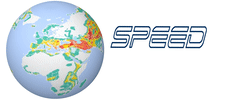Introduction

(a) 3D hexahedral spectral element mesh adopted for the computation of the Grenoble benchmark with the SPEED software package. The computational domain is subdivided into small chunks, each of which is sequentially meshed starting from the alluvial basin down to the bedrock. (b) Detailed view (from the bottom) of the alluvial basin mesh. (c) Mesh strategy adopted to best fit the soft soil-bedrock interface.
Numerical Model
The seismic response of the valley of Grenoble (French Alps) has been the object of an international benchmark for 3D numerical simulation of seismic-wave propagation in near-fault conditions. Referring to Chaljub et al. (2007) and Dumbser et al. (2007) for a more detailed description of the benchmark specifications, it is sufficient to recall here that the numerical model was constructed based on a 250 m resolution digital elevation model ( DEM ) of the surrounding topography and of the shape of the basin, with a simplified description of the dynamic properties of the soil layers. The final mesh consists of 216.972 elements, the sizes of which range from a minimum of about 20 m (inside of the alluvial basin) up to 900 m. The mesh is designed to propagate frequencies up to 2 Hz with a spectral degree of 3 and up to around 3 Hz with a spectral degree of 4.
Comparison with other numerical methods
Comparison of velocity waveforms at selected receivers as denoted by the superimposed rectangle, simulated by two independent approaches for seismic wave propagation analyses: SPEED and the ADER-DG discontinuous Galerkin approach (Käser et al., 2007). The numerical simulation presented here refers to the benchmark specifications denoted as Strong motion 1 (Dumbser et al., 2007) and corresponds to a scenario earthquake originated by the Eastern segment of the Belledonne Border Fault, with MW 6.
Variability of earthquake ground motion in near-fault conditions: role of hypocenter location and non-linear soil material behavior.
We address the role of the hypocenter location and of the nonlinearity of soil material behaviour. In this parametric analysis we consider the Mw 6 earthquake along the Eastern Belledonne fault, as prescribed in the Grenoble benchmark. The maps clearly show the dramatic effect of the complex interaction between the radiation mechanism, the hypocenter location and the corresponding directivity effects with the complicated shape and the soft sediments in the Grenoble basin. The largest values of ground motion occur in the Grenoble basin along the fault strike direction and consist first of a large basin-edge induced amplification, followed by energy trapping inside the Southern part of the basin.
Comparison with Ground Motion Prediction Equations (GMPEs)
In spite of an overall agreement in terms of average values, numerical results tend to group according to spatial clusters that are strongly dependent on the complex interaction between the rupture directivity and the location of the basin with respect to the fault trace.
References
Chaljub, E., D. Komatitsch, J.-P. Vilotte, Y. Capdeville, B. Valette, and G. Festa (2007). Spectral element analysis in seismology, in Advances in Wave Propagation in Heterogeneous Media, Ru-Shan Wu and Valérie Maupin (Editors), Advances in Geophysics, Vol. 48, Elsevier, New York, 365–419.
Dumbser, M., M. Käser, and F. T. Eleuterio (2007). An arbitrary high-order discontinuous Galerkin method for elastic waves on unstructured meshes—V. local time stepping and p-adaptivity, Geophys. J. Int. 171, 695–717.
Käser, M., M. Dumbser, J. De la Puente, and H. Igel (2007). An arbitrary high order discontinuous Galerkin method for elastic waves on unstructured meshes iii: viscoelasti attenuation, Geophys. J. Int. 168, 224–242.




